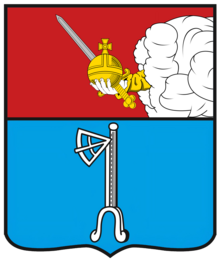Kholmogory, Arkhangelsk Oblast
You can help expand this article with text translated from the corresponding article in Russian. (January 2022) Click [show] for important translation instructions.
|

Moscovia

Kholmogory (
Antonievo-Siysky Monastery. The name is derived from the Finnish Kalmomäki for "corpse hill" ("cemetery"). Population: 4,150 (2010 Russian census);[1] 4,592 (2002 Census);[2] 5,205 (1989 Soviet census).[3]
The Kholmogory area was at first in historical times inhabited by the Finno-Ugrians "Zavolochskaya Chud", (i.e. "the
Lisowczycy besieged the wooden fort during the Time of Troubles
(1613), but had to retreat in failure.
Exile and prison camps
During the 17th and 18th centuries, the settlement was also a place of exile, notably for ex-regent
Bolshevik regime. The death toll was so large and Kedrov's behaviour so cruel that he was relieved of his duties and put in psychiatric care.[4]
Cathedral
In 1682, the six-pillared Kholmogory cathedral was consecrated; the biggest in the region. It was disfigured by the Communists in the 1930s. Many ancient wooden shrines and mills, however, still survive in the neighborhood. One of the nearby villages is the birthplace of the Russian polymath Mikhail Lomonosov. Local artisans—such as Fedot Shubin—have been famed for their craft of carving the tusks of mammoths and walruses.
In Kholmogory, a craft of
Peter the Great. Currently the carving is being performed at the Lomonosov Bone Carving Factory.[5]
References
- ^ Russian Federal State Statistics Service (2011). Всероссийская перепись населения 2010 года. Том 1 [2010 All-Russian Population Census, vol. 1]. Всероссийская перепись населения 2010 года [2010 All-Russia Population Census] (in Russian). Federal State Statistics Service.
- ^ Federal State Statistics Service (May 21, 2004). Численность населения России, субъектов Российской Федерации в составе федеральных округов, районов, городских поселений, сельских населённых пунктов – районных центров и сельских населённых пунктов с населением 3 тысячи и более человек [Population of Russia, Its Federal Districts, Federal Subjects, Districts, Urban Localities, Rural Localities—Administrative Centers, and Rural Localities with Population of Over 3,000] (XLS). Всероссийская перепись населения 2002 года [All-Russia Population Census of 2002] (in Russian).
- ^ Всесоюзная перепись населения 1989 г. Численность наличного населения союзных и автономных республик, автономных областей и округов, краёв, областей, районов, городских поселений и сёл-райцентров [All Union Population Census of 1989: Present Population of Union and Autonomous Republics, Autonomous Oblasts and Okrugs, Krais, Oblasts, Districts, Urban Settlements, and Villages Serving as District Administrative Centers]. Всесоюзная перепись населения 1989 года [All-Union Population Census of 1989] (in Russian). Институт демографии Национального исследовательского университета: Высшая школа экономики [Institute of Demography at the National Research University: Higher School of Economics]. 1989 – via Demoscope Weekly.
- ISBN 978-0-375-75771-6.
- ^ Холмогорская резная кость. Great Soviet Encyclopedia.
External links
- An 18th-century walrus-ivory chess set from Kholmogory
- Modern works of Kolmogory craftsmen
- Kholmogory Bone Carving

